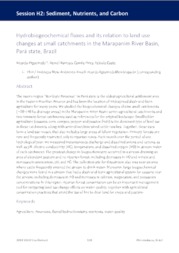Hydrobiogeochemical fluxes and its relation to land use changes at small catchments in the Marapanim River Basin, Pará state, Brazil.
Hydrobiogeochemical fluxes and its relation to land use changes at small catchments in the Marapanim River Basin, Pará state, Brazil.
Autoria: FIGUEIREDO, R. de O.; BARROSO, D. F. R.; PIRES, C. S.; COSTA, F.
Resumo: Abstract; The macro region "Nordeste Paraense" in Pará state is the oldest agricultural settlement area in the Eastern Brazilian Amazon and has been the location of widespread slash-and-burn agriculture for many years. We studied the biogeochemical changes of nine small catchments (~20-140 ha drainage areas) in the Marapanim River Basin: seven agricultural catchments and two remnant forest catchments used as references for the original landscape. Smallholder agriculture (cassava, corn, cowpea, pepper and passion fruit) is the dominant type of land use in these catchments, along with several medium-sized cattle ranches. Together, these uses form a land use mosaic that also includes large areas of fallow vegetation. Primary forests are rare and frequently restricted only to riparian zones. Each month over the period of one hydrological year, we measured instantaneous discharge and dissolved anions and cations, as well as pH, electric conductivity (EC), temperature, and dissolved oxygen (DO) in stream water of each catchment. The greatest change in biogeochemistry occurred in a stream draining an area of abundant pasture and no riparian forest, including decreases in DO and nitrate and increases in ammonium, pH, and EC. The collection site for this stream also was near an area where cattle frequently entered the stream to drink water. Moreover, large biogeochemical changes were found in a stream that had a slash-and-burn agricultural system for cassava near the stream, including decreases in DO and increases in calcium, magnesium, and potassium concentrations. In this region, riparian forest conservation can be an important management tool for mitigating land use change effects on water quality, together with agricultural conservation practices that avoid the use of fire to clear land for crops and pasture.
Ano de publicação: 2014
Tipo de publicação: Resumo em anais e proceedings
Unidade: Embrapa Meio Ambiente
Palavras-chave: Agricultura, Amazonia, Biogeochemical cycles, Fluvial hydrochemistry, Land use, Qualidade da água, Uso da terra, agriculture, nutrients, water quality
Observações
1 - Por padrão são exibidas publicações dos últimos 20 anos. Para encontrar publicações mais antigas, configure o filtro ano de publicação, colocando o ano a partir do qual você deseja encontrar publicações. O filtro está na coluna da esquerda na busca acima.
2 - Para ler algumas publicações da Embrapa (apenas as que estão em formato ePub), é necessário ter, no celular ou computador, um desses softwares gratuitos. Sistemas Android: Google Play Livros; IOS: iBooks; Windows e Linux: software Calibre.
Acesse outras publicações
Acesse a Base de Dados da Pesquisa Agropecuária (BDPA) para consultar o acervo completo das bibliotecas da Embrapa.

